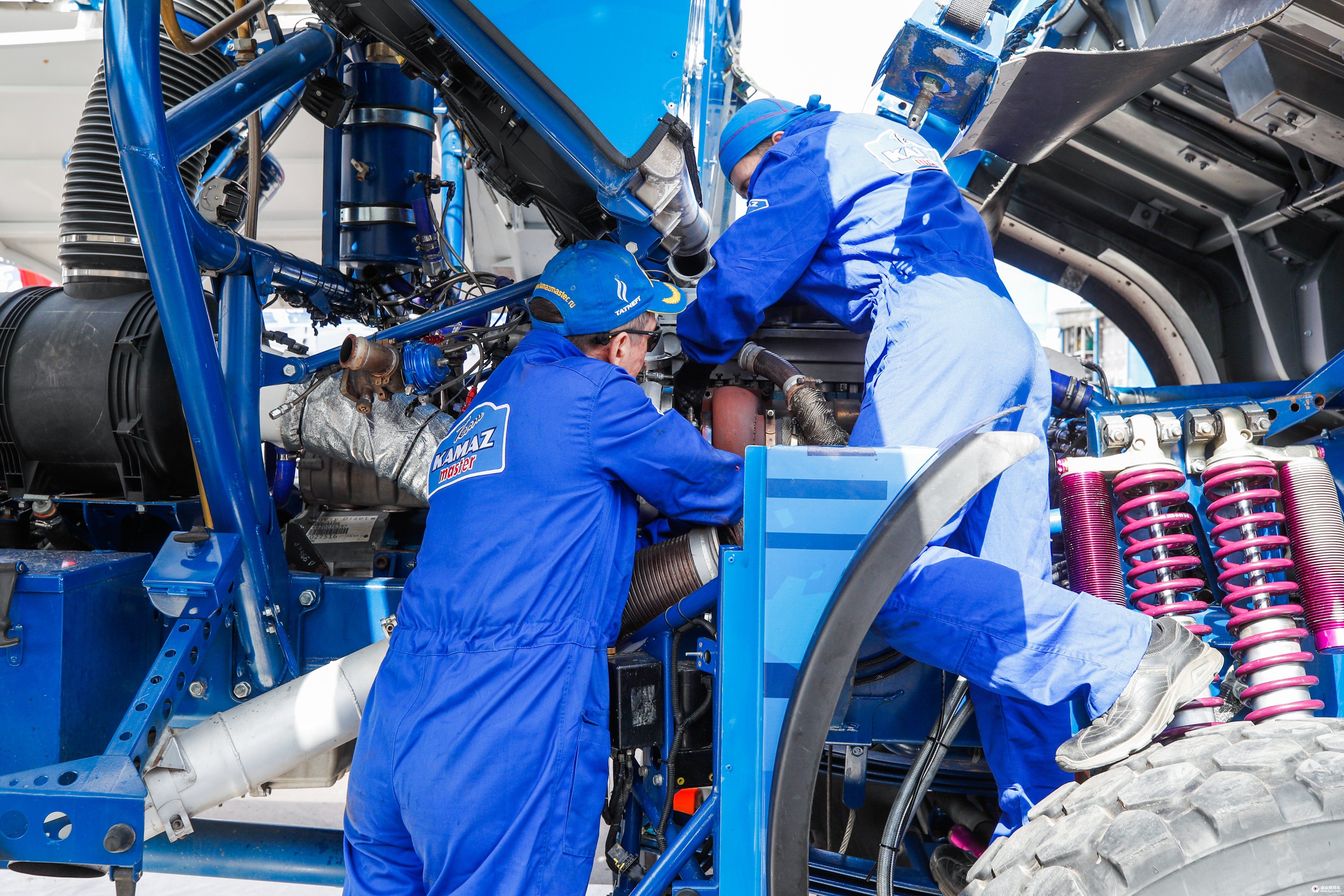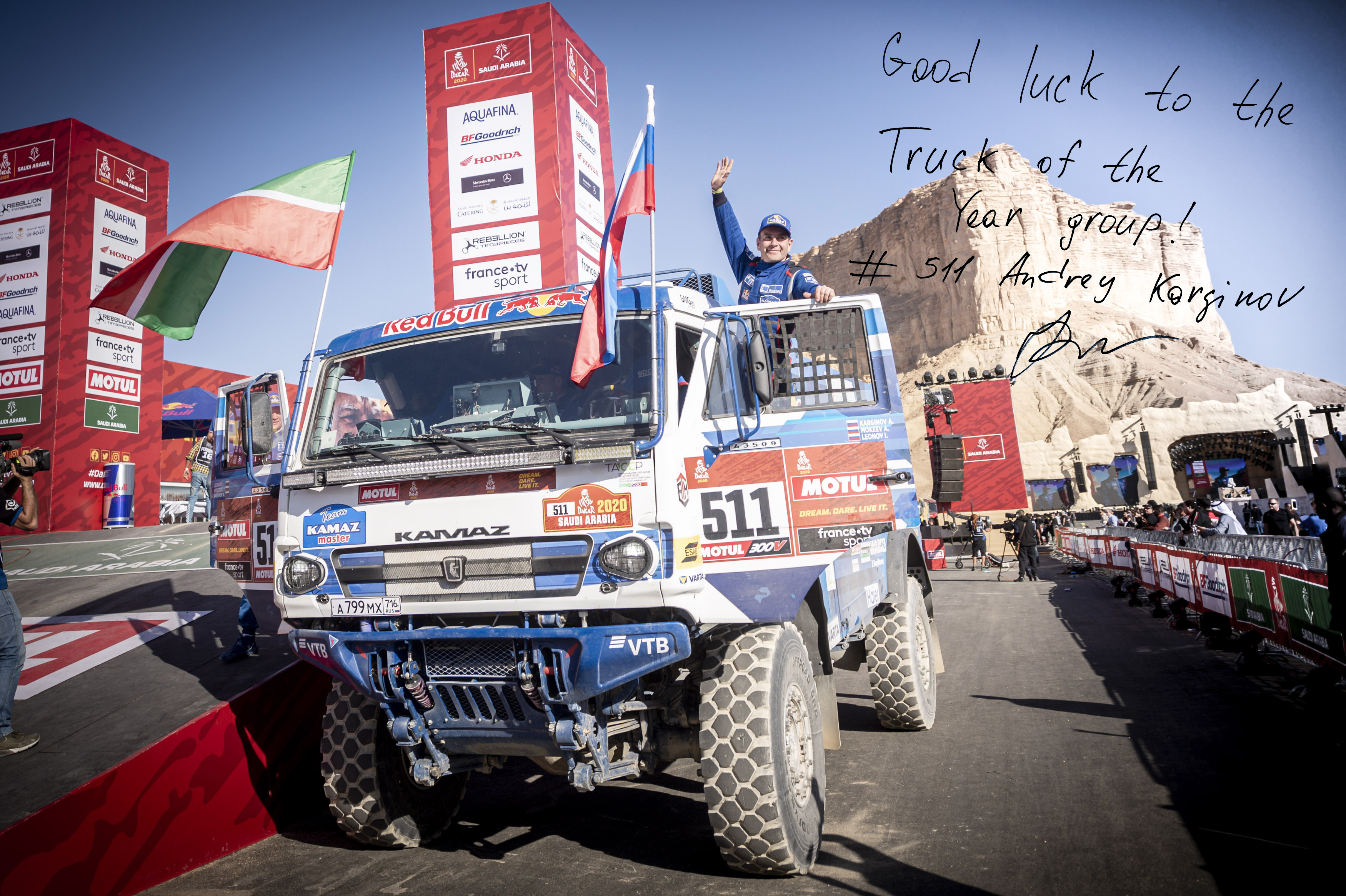Russian rally raid driver Andrey Karginov took top honours in the 2020 Dakar Rally in the truck category for Kamaz. Gianenrico Griffini meets the man behind the chequered flag …

Two Kamaz crews finished on the podium in Qiddiya and another Kamaz truck was placed in fourth position in the final ranking. Did you expect this result before starting the rally – especially given the uncertainties of the first Dakar in the Arabian Peninsula?
Every time we go to competitions, especially to the Dakar (the most challenging race of the year) we go with certain objectives. So too does the rest of the rally raid world. Everyone goes with their ambitions; everyone wants to show the best possible result. As for our team, we had the following task: to win the race. We took first, second and fourth places. It can be said that the result was excellent. The race was difficult. Both the pace that was set by our rivals and sometimes our own fast pace raised concerns as to whether the vehicles and crews would cope. But, once again, we have proved that we are a strong team and can win.

How do you compare the Dakar in South America with the Dakar in Saudi Arabia? Was this year’s rally more or less difficult than last year’s race? Why?
There are common features, and, of course, differences. First, during the Dakar it is summer in South America, and winter in Saudi Arabia. On the one hand, Saudi Arabia is slightly better because there is no exhausting heat. But, at night, the temperature was very cool. You can even say cold; it reached almost zero degrees. The mechanics had to wear very warm clothes in order not to freeze while doing their jobs.
The second difference is that there were no high altitudes during the event in Saudi Arabia. This was easier for the body, more comfortable for the vehicles and the engines felt better too.
Furthermore, the travelling time was shorter, and it was easier to adapt to the racing conditions. Having said this, the tracks on the Dakar 2020 were very diverse. There were high-speed sections, where we could drive at maximum speed, sandy tracks and dunes of various complexity. There were rocky sections and roads with huge boulders as well as "killer" winding riverbeds. We were presented with all the types of terrain that we love in rally raids.

Can you explain the main reasons for your performance this year? Is it, as in the past, mainly due to the tests you carried out before the rally, the ability of your Kamaz 43509 rally truck, the teamwork, the tactics and the strategies of your team manager Vladimir Chagin or perhaps the reliable Dongfeng Cummins 13-litre engine?
You cannot give one reason only. This is a mechanism that works as a whole. The team has masses of experience and we review the team tactics every day. We train extensively during the year. The competitions in which we participate during the year also contributed to our result at the Dakar. Both the truck and the engines are reliable. When all these factors were combined, we produced a good result.
Did you use an automatic gearbox this year? If so, why? Do you like it?
Yes, from this year, all four sports crews drove with an automatic gearbox. Last year, only two drivers went with an automatic gearbox (the other two, including me, used a manual transmission). I drove on the Silk Way Rally for the first time with the automatic gearbox. Its main advantage is in the dunes, in heavy sand, where it is necessary to change gears constantly. With a manual gearbox, this is more difficult and, probably, you lose more time. If, for example, you skid, then there are definite advantages to the automatic gearbox.

Can you tell us, in some detail, the story of your Dakar this year? What were the main turning points of this year's rally?
The organisers of the Dakar aim to make it an unforgettable adventure. Every year they try to surprise contestants. This year they certainly succeeded. There was a huge variety of tracks and they were also very complex. There were lots of sharp stones on the route, and I was constantly mindful of the need to avoid punctures.
The final 100 km was populated by huge boulders that I had to avoid while still going fast. It was extremely risky – because the truck could have endured serious damage. At the finish line, many of the frontrunners in the car category said that it was the most difficult 100 km in the history of the Dakar.

Who was the most challenging competitor this year? Viazovich?
I respect all the competitors. Everyone is working towards a good result and a victory. Having said that, the MAZ (with Siarhei Viazovich), Tatra, Hino and Renault teams were all strong – as were Iveco's Gerard De Rooy and Federico Villagra. From time to time, they all achieved good results. It may be said that our performance was more consistent and, in the aggregate of all the days, we showed the best time.
How would you describe your driving style? Are you aggressive, cool or perhaps a tactician?
I use all three styles. Sometimes I need to go fast, and this involves aggressive driving, but I'm mindful of exposing myself and my truck to as little risk as possible. This is not always achievable. I also bear in mind the team tactics. All this combines to achieve a good result.

Where do you feel at your best as a pilot? On rocky stretches? Soft desert sand? Dunes? Narrow and winding routes?
Our team says this of certain tracks: "The worse, the better it is." The tracks to which they are referring are the "killer" winding stony riverbeds – and those are the conditions that I like best. It's not very enjoyable to race over a mountainous special stage where you cannot cut corners because you need to drive in a fixed track. On mountain stages, there's usually a hill on the one side and a dropoff on the other, so if you cut the corners, you die. You obviously need to be especially cool-headed in those conditions. I love dunes. You do not have to drive fast in the dunes; you need to overcome them without getting stuck.
Can you outline the major steps in your career as a pilot of rally trucks? Where and when did you start driving a rally truck? I suppose in Chelny?
Yes, my career began in Naberezhnye Chelny with karting. Although karts are essentially small cars, they have much in common with a truck – a sense of steering, reaction and a desire to win, for instance. Karting teaches a motor sportsman a great deal. And sitting behind the wheel of a truck, you just make corrections and expand these skills. All of my skills and my achievements as a pilot are thanks to the team. The team has taught me everything.

Would you like to drive a bonneted truck, instead of a cabover truck?
I drove a bonneted truck during one training session, and I experienced its advantages. But, in order to learn how to manage it, you cannot simply drive one in a race or two; you need to drive it over a year. I am sure that our bonneted truck will become a worthy rival in the future. For now, however, we have developed our cabover version to such a level that it is extremely competitive and performs well. It is currently the main focus for the team.

Finally, can you tell us anything about your future projects?
Our main project is our racing truck, its modernization and its ongoing improvement. As a driver, I am primarily interested in improving its sporting qualities. I want to make it faster. Certainly, it needs testing. We can do this at the Silk Way Rally; this event allows us to test both the truck and our driving skills. The Silk Way Rally takes place in three different countries and it offers a variety of tracks: dunes, sand, hard tracks and slippery off-road sections. Competition is stiff. If you succeed at the Silk Way Rally, you can go to Dakar with confidence




发表评论
网友评论仅供其表达个人看法,并不代表商用汽车事业部立场。